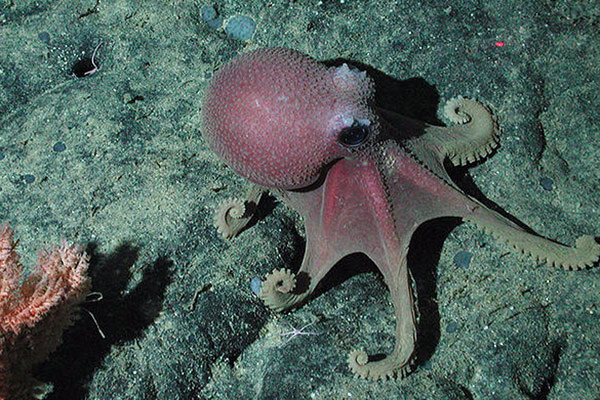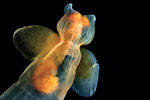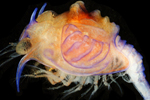Scientists discover that Graneledone boreopacifica has the longest brooding time of any animal on the planet
The ultimate goal of all species on the planet is procreation, the act of making anew. And many species go to great lengths to set their progeny off on the right path: orangutan mothers have been known to breast feed for eight years, the father emperor penguin braves the brutal Antarctic winter to warm a single egg, while the mother wolf spider carries her dozens of offspring wherever she goes. However, few could contend with a deep-sea octopus, known as Graneledone boreopacifica, which researchers have recently observed guarding its eggs for four-and-a-half years (53 months), before likely succumbing to starvation soon after.
“At 53 months, it is by far the longest egg-brooding period ever reported for any animal species,” the researchers write in a paper on the discovery published today in the open-access journal PLOS ONE.
In March 2007, the marine biologists, headed by Bruce Robison from the Monterey Bay Aquarium Research Institute, used a remotely-operated vehicle to visit a deep sea site in the Monterey Submarine Canyon off of central California. At 1,397 meters (4,583 feet) deep they came on a female Graneledone boreopacifica protecting a brood of its eggs. A month earlier, when the ROV had visited the same site, the octopus hadn’t been there.
“Given this singular opportunity to measure the length of a brooding period from its inception, we returned to the site 18 times over the ensuing four-and-a-half years,” the scientists write. “Each time we returned we found the same octopus clinging to the vertical rock face, arms curled, covering her eggs. Continuous growth of the eggs provided evidence that it was the same clutch throughout.”

The female octopus was also easily identifiable by her tell-tale scars. After 53 months–in the Autumn of 2011–the eggs hatched. When the scientists visited the last time the eggs were empty and the mother was gone, presumably perished.
Many octopus mothers, such as the giant Pacific octopus (Enteroctopus dofleini), are known to lay eggs only once in their lives. They guard and care diligently for the eggs, all the while losing weight and weakening due to a lack of food. They also change color, usually taking on a ghostly pallor. The mothers often die soon after the eggs hatch, essentially sacrificing themselves for the success of their children. The researchers believe Graneledone boreopacifica acts similarly.
“There is no evidence that [Graneledone boreopacifica] females feed while brooding. Potential prey in the form of Lithodid crabs and Pandalid shrimps were frequently in close attendance around the brooding female that we monitored. However, the only interactions we observed were when she pushed these crustaceans away,” the researchers write.
Moreover, the mother even refused food when the ROV offered her pieces of crab. The scientists also never observed the mother away from her eggs during the 18 visits over the years.
“While she occasionally shifted her position slightly, or uncurled and lifted one or two arms, the female always remained centered
over the clutch of eggs,” the scientists write.
Biologists believe that octopi have developed such diligence in order to protect their offspring from predators during the hugely-vulnerable egg stage. Moreover, the growing eggs require constant influxes of oxygen, so octopus mothers’ squirt water on the egg brood repeatedly, essentially bathing them with oxygen.

However, most self-sacrificing octopus mothers are known to brood eggs for a few months (it’s up to seven months for the giant Pacific octopus), not four-and-a-half years.
“These surprising results emphasize the selective value of prolonged embryonic development in order to produce competitive hatchlings,” the researchers write. “They also extend the known boundaries of physiological adaptations for life in the deep sea.”
In other words, the researchers believe this deep sea octopus has evolved such a long brooding time in order to produce incredibly well-developed babies. In fact, Graneledone boreopacifica hatchlings are the “largest and most developmentally advanced octopus hatchlings known,” according to a 2004 paper in the Journal of Molluscan Studies.
In all, the researchers counted between 155 and 165 octopus eggs after the larvae hatched. While this may sound like a lot, it’s actually a small brood compared to other octopus species which lay tens-of-thousands of eggs.

Another reason why Graneledone boreopacifica may brood her offspring for so long has to due with extreme conditions in the deep ocean. For one thing, the chilly temperatures slow down metabolic rates, perhaps making it necessary for larvae to wait longer to fully develop.
“These surprising results emphasize the importance of parental care in producing well-developed offspring that can cope with the rigors of the deep-sea habitat,” Bruce Robison said.
He adds that global warming may put the species in peril: “because the brooding period is temperature dependent, the results also provide a caution about the potential consequences of our changing climate.”
But such a long brood time actually appears to drastically extend the life of Graneledone boreopacifica. Most shallow-water octopus species live less than two years, but during brooding Graneledone boreopacifica lived twice as long. How long she may have lived before egg laying is another question, however in other octopus species the brooding period represents around a quarter of their life. So, theoretically, this species may survive around 18 years, an incredible lifespan for an octopus.
Clearly though there’s much more to learn about how this species and many other deep sea animals survive, most of which have never been studied. In fact Graneledone boreopacifica, which is generally considered a common deep sea octopus, was only discovered by science in 1982.
Graneledone boreopacifica has no common name–unfortunately–but given this recent discovery, perhaps we should start calling it the “mother octopus.”


Citations:
- Robison B, Seibel B, Drazen J (2014) Deep-Sea Octopus (Graneledone boreopacifica) Conducts the Longest-Known Egg-Brooding Period of Any Animal. PLoS ONE 9(7): e103437. doi:10.1371/journal.pone.0103437
- Voight, Janet R., and Jeffrey C. Drazen. “Hatchlings of the deep‐sea octopus Graneledone boreopacifica are the largest and most advanced known.” Journal of molluscan studies 70, no. 4 (2004): 400-402.
Related articles
Wonderful Creatures: the bizarre-looking marine worm with an incredibly important ecological role

(02/13/2014) Almost everyone knows what an earthworm is, but these very familiar animals are just one variation on a very rich theme that is at its most fabulously varied in the oceans. The mind-boggling appearances and lifestyles of the marine segmented worms are perfectly exemplified by this week’s animal.
Animal Earth: exploring the hidden biodiversity of our planet

(12/03/2013) Most of the species on Earth we never see. In fact, we have no idea what they look like, much less how spectacular they are. In general, people can identify relatively few of their backyard species, much less those of other continents. This disconnect likely leads to an inability in the general public to relate to biodiversity and, by extension, the loss of it. One of the most remarkable books I have read is a recent release that makes serious strides to repair that disconnect and affirm the human bond with biodiversity. Animal Earth: The Amazing Diversity of Living Creatures written by Ross Piper, a zoologist with the University of Leeds, opens up the door to discovery.
California ‘sea monster’ is an oarfish
(10/16/2013) The dead “sea monster’ spotted off the coast of Southern California on Sunday is actually an oarfish, a deepwater fish species that can reach a length of 55 feet (17 meters).
Sacrificial squid has unique way of deterring predators
(09/04/2012) Octopoteuthis deletron—this deep-dwelling, unassuming little squid may appear plain and boring, but when threatened, it has a peculiar way of defending itself. This foot-long invertebrate behaves a bit differently than most of its close cousins: it drops its arms.
‘Monster larva’ turns into a shrimp

(08/28/2012) With blue devil-shaped horns and red armor, the monster larva, or Cerataspis monstrosa, kept scientists guessing for nearly 200 years; infrequently found in the bellies of marine predators, researchers could not imagine what this larva became as an adult. Now they do: the monster larva becomes a deep sea shrimp, known as Plesiopenaeus armatus, which bares little monstrous resemblance to its larval stage, according to DNA studies published in Ecology and Evolution.
Controversial deep sea mining project approved in Papua New Guinea, first of its kind
(08/09/2012) The Papua New Guinea government has granted a 20-year license for copper and gold mining around a mile (1.6 kilometers) below the ocean’s surface, jump-starting the world’s first commercial deep sea mining venture. Undertaken by Canadian company, Nautilus Minerals, the venture will mine deep sea hydrothermal vents off the coast of New Britain. However, the project faces stiff concern from local activists, fishermen, and environmentalists.
New tiny crustacean discovered in deep sea off Europe (photo)
(06/20/2012) Scientists have pulled up a tiny new species of ‘squat lobster’ from a deep sea mountain at 1,410 meters below sea level off the coast of Spain. Dubbed Uroptychus cartesi, this is only the fourth species in this genus from the eastern Atlantic Ocean, although there are over hundred unique species in the Pacific and Indian ocean. The new species measures just 5-7 centimeters.
BP Deepwater Horizon deformities: eyeless shrimp, clawless crabs
(04/24/2012) Two years after the BP-leased Deepwater Horizon drilling rig exploded in the Gulf of Mexico, killing eleven and causing an oil spill that lasted three months, scientists say the impacts on the Gulf ecosystem are only beginning to come to light and the discoveries aren’t pretty.